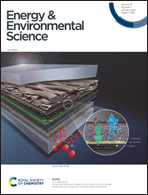Inhibiting excessive molecular aggregation to achieve highly efficient and stabilized organic solar cells by introducing a star-shaped nitrogen heterocyclic-ring acceptor†
Abstract
Inhibiting excessive aggregation and migration of active layer molecules is essential to improve the stability and performance of organic solar cells (OSCs). Herein, the star-shaped nitrogen heterocyclic-ring acceptor TF1 featuring a unique 3D skeleton was elaborately selected as the third component for a PM6:Y6 system to suppress the extensive aggregation of Y6, and further improve the device stability and performance of OSCs. TF1 possesses a complementary absorption spectrum and a higher lowest unoccupied molecular orbital (LUMO) level compared to Y6, as well as excellent miscibility with Y6. Thus, the incorporation of TF1 in the ternary film gives rise to the enhanced short circuit current density (Jsc), elevated energy of charge transfer state (ECT) and reduced voltage loss in ternary OSCs. Meanwhile, it is found that incorporation of TF1 into the PM6:Y6 blend will also increase the exciton lifetime and diffusion distance, facilitate exciton dissociation and collection, reduce trap-assisted recombination, and accelerate the hole transfer rate. As a result, compared to the binary devices, the ternary OSCs with 10% TF1 contents achieved simultaneously improved power conversion efficiency (16.67%), open-circuit voltage (0.870 V), Jsc (25.63 mA cm−2), fill factor (74.79%) and stability, which are among the best results reported in the literature to date. Moreover, a superior efficiency approaching 17% of ternary OSCs was achieved by adopting the pseudo-planar heterojunction (PPHJ) structure. This work not only puts forward an effective strategy to further improve the efficiency and stability of OSCs, but also systematically revealed the inner working mechanism of star-shaped small molecules in ternary OSCs.



 Please wait while we load your content...
Please wait while we load your content...